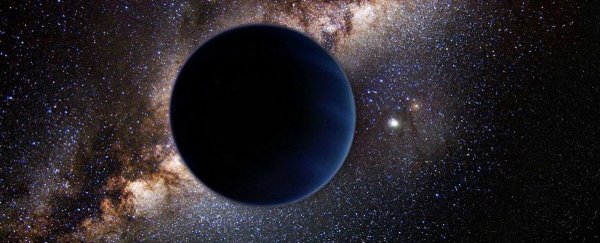Scientists are still trying to track down the exact location of the elusive Planet Nine – the hypothesised ninth planet of our Solar System that was proposed by scientists in January last year.
But while they're at it, new research has offered up an explanation for how this huge and mysterious world could have come to orbit our Sun in the first place: it was once a free-floating nomad, before it got snatched into our Solar System by the gravitational pull of the Sun.
According to simulations, Planet Nine may be what's called a rogue planet – a free-roaming planetary body that's not bound to any particular star.
Or at least, it was one back in the day, before wandering into our Solar System at some point, and getting captured by the gravitational pull of the Sun.
That's what two researchers from New Mexico State University are suggesting, after running 156 simulations of what could occur if orphan planets of varying sizes were to roam into our local corner of the galaxy.
Most of the time, the tests showed that these nomads wouldn't get stuck in our Solar System, with incoming planets most commonly ejected by gravitational forces in a kind of slingshot effect.
"[R]ogue in, rogue out," as lead researcher James Vesper explains to Mike Wall at Space.com.
Those ejections made up about 60 percent of the rogue encounter simulations. In at least 10 percent of those cases, the departing wanderer would take one of the Solar System's existing planets with it, due to the gravitational pull of the slingshot.
But in 40 percent of the simulations, the rogue planet was indeed pulled into the Solar System for keeps.
This could take place with a "soft capture" – where no existing planets get pushed out by the new arrival – or via a more violent insertion, with one, two, or more planets being kicked out by the invader.
The findings were presented last week at the Meeting of the American Astronomical Society in Grapevine, Texas, and while the new paper hasn't been formally peer-reviewed just yet, it has scored praise from Konstantin Batygin – one of the Caltech planetary scientists whose 2016 research gave rise to the Planet Nine hypothesis.
"It is certainly plausible that Planet Nine is [a] captured object," Batygin told Rae Paoletta at Gizmodo.
"Without knowing the precise orbit, it is difficult to decisively confirm or refute rogue capture as Planet Nine's origin story, but it's certainly possible."
One of the factors that helps to underpin the rogue planet explanation is the sheer number of these wandering worlds that are estimated to be out there.
Scientists think there could potentially be billions of these orphans roaming throughout the Milky Way, outnumbering both the stars and star-bound exoplanets in our galaxy.
But there's another possibility too.
Last year, a separate team put forward the argument that Planet Nine might originally have been an exoplanet from another Solar System that got captured by our Sun billions of years ago.
In that analysis, Planet Nine wasn't a rogue, but rather a star-bound exoplanet that ended defecting to our Sun due to gravitational forces beyond its control.
Of course, all of these speculative explanations remain very much in the realm of the hypothetical for now, but with every new piece of research and understanding that we muster, it feels like we're edging closer to what could be one of the most exciting scientific discoveries about our Solar System ever. But we have to find it first.
"I'm quite certain that Planet Nine is really out there," Batygin told Gizmodo.
"The number of seemingly unrelated puzzles within the Solar System that are resolved by Planet Nine's existence is simply too great for it all to be a coincidence."
